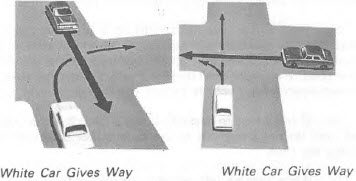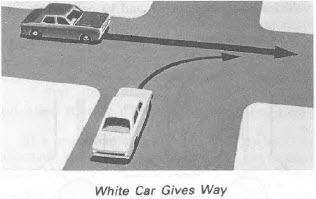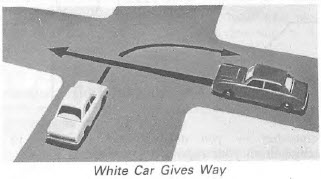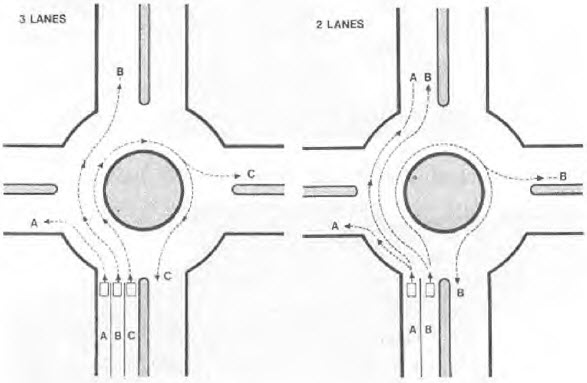|
| 66. Do not make a U-turn at any road intersection, junction or any opening in a road divider unless permitted to do so by a traffic sign. |
| Following Distances |
67. To be able to adjust your speed so that you can stop within the space between you and the vehicle in front, you must allow at least one car length for every 16 km/h of your speed.
|
| 68. Watch for the stop light on the car in front and the traffic ahead of the car in front. |
| Speed and Stopping |
69. It takes a longer distance to stop a moving vehicle than most people think. You must study and remember the information given in the chart in paragraph 67.
|
| 70. When approaching a junction with a major road, slow down gradually and give way to traffic on the major road. Where there is a “STOP” sign, stop at the major road. |
| 71. Where there are no traffic lights, give way signs or stop signs, give way to all traffic on your right, including cyclists. See illustrations in paragraph 69. |
| 72. At a junction look right, then left, then right again. Do not go on until you are sure that it is safe to do so. Do not rely on signals to go ahead given by unauthorised persons. |
| 73. Well before you turn right at a junction, take full account of the position and movement of traffic behind you. Signal your intention and take up a position just left of the middle of the road. Wait there until there is a safe distance between you and any approaching vehicle before you complete your turn. |
| 74. If you intend to turn left, keep to the left, signal in good time, and do not swing out to the right either before or after making the turn. |
| 75. When turning left or right, drivers must always give way to vehicles going straight on and to pedestrians. |
76. Slow down when approaching a roundabout, and give way to traffic on your right.
|
| Safety of Pedestrians |
| 77. Pedestrians have the right of way on pedestrian crossings. |
| 78. When approaching a pedestrian crossing slow down and do not overtake other vehicles. |
79. When approaching a pedestrian crossing always —
|
| 80. At a pedestrian crossing controlled by light signals or by a policeman, give way to pedestrians who are crossing when the signal to stop is given. |
| 81. When a school patrol sign is extended at a pedestrian crossing, vehicles travelling in both directions must stop and remain stationary until the whole crossing is clear and the sign has been removed. |
| 82. Watch for the pedestrian who comes out suddenly from behind stationary vehicles and other obstructions. Be very careful near schools and bus stops. When turning at a road junction, give way to pedestrians who are crossing. |
| 83. On rural roads watch out for pedestrians and give them plenty of room. |
| Reversing |
| 84. Before you reverse make sure that there are no children or other pedestrians or obstructions in the blind area behind you. |
| 85. Do not reverse from a side road onto a main road. |
| 86. If your view to the rear is restricted, get help when reversing. |





